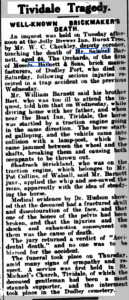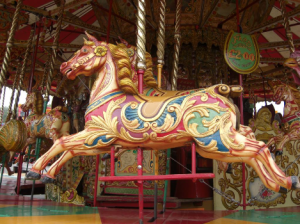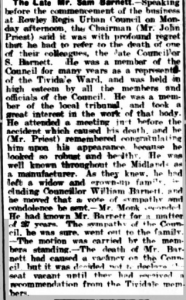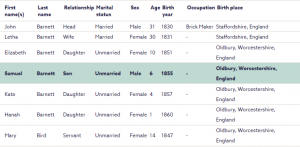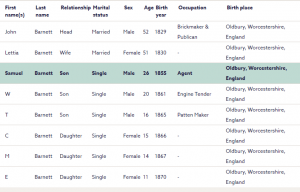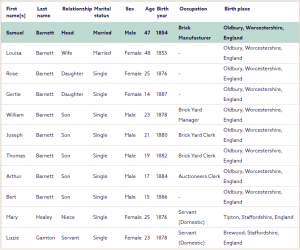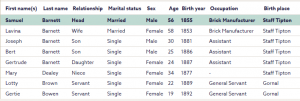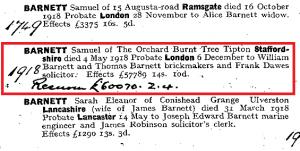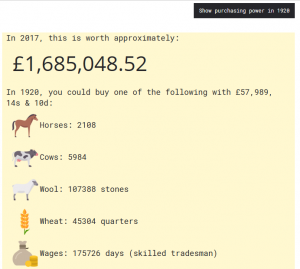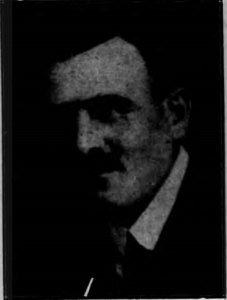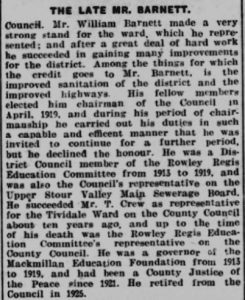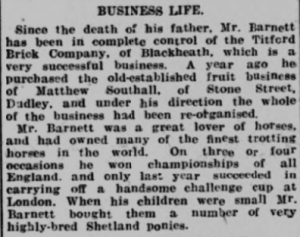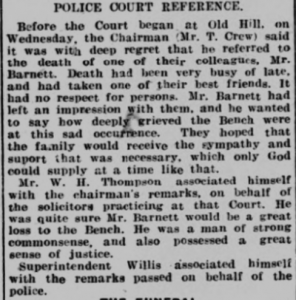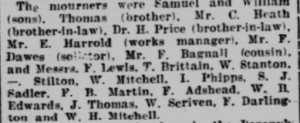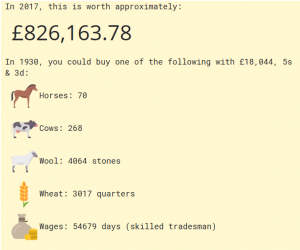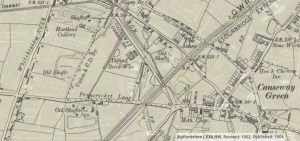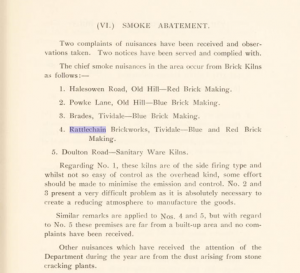I have previously outlined how workers at Samuel Barnett‘s dangerous Rattlechain brickworks site had died but had received little in the way of public attention. Another had seriously broken his leg leaving him unable to work.
The main architect of the creation of Rattlechain lagoon, a 100 yards deep claypit which had flooded due to dubious practices of placing hot ashes near to the canal bank, had already lost his left arm in earlier life at the nearby Stour Valley Brickworks, but received the ultimate karma when falling from his horse and cart.
I have found another article from The Dudley Chronicle of 11th May 1918 which gives a far more graphic account of his injuries, and also throws further light on one of his sons William. Both were local councillors in a time when money bought you a great deal, and when connections with the bench could certainly bring you dodgy legal victories against your opponents.
The 64 year old brickmaker, born in 1854, had died in a collision with a lamp post after his cart had been startled by a tram.
There is something rather farcical in the detail of what happened, the traction engine driven by “Shadrach Strickland”- what a name, who was employed by Pat Collins of the Walsall funfair fame.
Barnett’s last ride 😆 had seen him and his son Bert thrown out. Barnett senior had fractured his skull, broken his pelvis, and had obviously suffered great shock after the “Greatest showman’s” owned vehicular manoeuvre. Collins himself would become a politician in this very year, and future mayor of Walsall. Funny how people in business get on isn’t it?
On 1st June 1918 , from the same paper, and following the funeral, we get the political eulogy at the Rowley Regis Urban council meeting. Barnett Snr apparently represented The Tividale ward (or more aptly his own business interest in this area), and had been a councillor for many years.
I’m afraid these sycophantic political affairs leave me absolutely cold, and do not change my mind at all that this man was a wrong un, who could buy whatever he wanted.
THE LIFE AND TIMES OF SAMUEL BARNETT
From census records it is possible to trace the life of Tividale’s brick making “righty” supremo. The first record dates from the 1861 census, where he was 6, though for some reason there appears to be speculation as to whether the year of birth was a year later. Born to brickmaker John, and “Letha”, the address of Portway Road Oldbury is given, and by this time, he had already got 4 siblings. It is also interesting to note that a servant lived with the family. I’m not sure at what factory his father worked or owned, but it is clear that this was already a wealthy family for the area.
By 1871, The family had swelled to 9 children- how they loved putting them in the kilns in those days. 😆 By now, Barnett would have had his accident and obviously was looking to follow in his father’s footsteps.
In 1881, the address given is now The Three Crowns Inn, Portway Road, where John is listed as publican and brickmaker. Samuel at 26 still lives at home and is listed as an “agent.”
By 1891, the intervening ten years sees “Brickmaster” Samuel married to “Levina”, and now residing at an address in Brades Road, Oldbury. They have churned out 7 moulds, including sons William, Joseph, Arthur and Bert. A “Mary Hailey” who is supposedly his sister also lives at the address.
Into the new millennium, and two years after the infamous canal breach, in 1901 Barnett Snr, now 47, and the year of birth changed to 1854, is listed as “brick manufacturer”. The Stour valley and rattlechain works were now on the go, and his sons were obviously being drawn into the trade- William– brick yard manager, Joseph and Thomas– brick yard clerks, and interestingly- Arthur– an auctioneers clerk. The family were now living in Tividale Road. His wife, obviously the same one appears on the transcript of the census, to change her name every ten years 😮 His sister Mary also appears to have a changing surname. He also employs a live in servant- obviously money making bricks could get you quite a bit.
In 1911, the last census for Sam of course, would see him still living in Tividale Road at an address known as “The Orchards”. Both he and his wife are listed as brick manufacturers, and his two sons Joseph and Bert assistants. Several children have now flown the nest, but Sam now employs two servants. The curious Mary is now listed in a third name as his niece! There is no “Julius Barnett” in existence, as stated in the 1912 Brick and Clay Record American article, in the last post I did.
There is a known story concerning his son Arthur. Obviously turning his back on the family business and indeed country, he made a new but short lived life in Australia, where he was killed in action in 1916 in The First World War. This must have had a devastating effect on his father, who commissioned a life size model dressed in knight armour which was placed in the former St Michaels Church in Tividale. The story goes that this was eventually thrown out for scrap, though pictures exist of what it looked like.
In terms of what he left behind financially, Samuel Barnett left a great deal of wealth from his brick works at the time of his death in 1918.
I’ve put this total into The National archives money convertor from 2017, and it is clear that he would have died a millionaire in todays terms. This would have been even more in the 1915 calculation and obviously declining due to the impact of the war.
His sons obviously carried on with this legacy, but the political brick building dynasty suffered a further blow with the death of Councillor William some 11 years later at the age of 51. The Dudley Chronicle of 14 March 1929 records what “greatness” he brought to Tividale, without actually mentioning a single evidential bloody thing.
It is interesting to note his connections with the sewerage board, given that his pecuniary interest in a brickworks lay right next to the sewage works in John’s Lane.
There is much more of this sanctimonious horse shit , which I have cut, but the names of some of the mourners are of note in relation to those in the employment at The Rattlechain brickworks. Frank Dawes crops up in 1899 with the canal breach fiasco, and must have been the go to consigliere for the family Barnett, and is mentioned in his will too.
Bricker Bill left a more modest sum than his father, to his Fanny, a brickworks manager Called George Harrold, and the ever appreciative Frank.
The Titford brickworks mentioned in the chronicle article were located on the Griffin Industrial Estate, next to where the M5 passes today near Causeway Green.
 I’m not sure what happened with the works at Rattlechain after this date, as it starts to get very clouded at this point, though some time near the 2nd world war, it came under control of the conman Sydney Sheldon, who did much to continue the self interest of the Barnett’s in making Tividale their very own stomping ground , and in his case an absolute shit tip.
I’m not sure what happened with the works at Rattlechain after this date, as it starts to get very clouded at this point, though some time near the 2nd world war, it came under control of the conman Sydney Sheldon, who did much to continue the self interest of the Barnett’s in making Tividale their very own stomping ground , and in his case an absolute shit tip.
From records from 1938, it is possible to see that it was an industrial smoke nuisance on the radar of the local board of health in Rowley Regis, (as well as the Brades works), in a report- what a great legacy the Barnett family gave to the area, where of course when councillors, they could have written off such complaints.
Personally I have no time for the Barnett family and those like them. No one would begrudge them making a living, in fact the brickmaking industry provided necessary materials, but their thirst for power through monopolisation and position made them greedy and arrogant, and their civic involvement made them think that they were untouchable.
It’s a character flaw seen in all others who followed in connection to this wretched brickworks and what was left behind from it. The Barnett’s ultimately made the vessel of Rattlechain lagoon and the dross that went into it, just like all the other clay hole diggers who left great voids in the land. They were the architects of a vile fetid waste industry and should never be feted.


